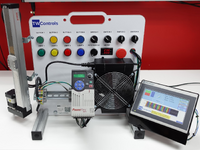eagle1109
Full Member level 6

- Joined
- Nov 20, 2014
- Messages
- 393
- Helped
- 4
- Reputation
- 10
- Reaction score
- 7
- Trophy points
- 1,298
- Location
- Saudi Arabia
- Activity points
- 5,956
Hello,
I bought this module from Aliexpress to attach it to a Mitsubishi PLC FX3U clone, that can output 0-10V analog DC voltage which isn't effective and enough to run a 24V DC fan. So I bought this module to solve this problem.
The module specs:
1. Power supply voltage 7-30V
2. Control input signal 0-5V or 0-10V can be selected with a jumper
3. 2 output signals: NPN can be 5 or 24V, PNP can only be 5V PWM signal
This is the connection:

The problem is that the fan only worked on PNP rail and didn't work on NPN.
I wired the output for PNP and NPN the same, the red wire goes to the output path NPN or PNP and the black goes to the one of the two GND pins.
Is there a problem with my NPN wiring ?
I bought this module from Aliexpress to attach it to a Mitsubishi PLC FX3U clone, that can output 0-10V analog DC voltage which isn't effective and enough to run a 24V DC fan. So I bought this module to solve this problem.
The module specs:
1. Power supply voltage 7-30V
2. Control input signal 0-5V or 0-10V can be selected with a jumper
3. 2 output signals: NPN can be 5 or 24V, PNP can only be 5V PWM signal
This is the connection:
The problem is that the fan only worked on PNP rail and didn't work on NPN.
I wired the output for PNP and NPN the same, the red wire goes to the output path NPN or PNP and the black goes to the one of the two GND pins.
Is there a problem with my NPN wiring ?





